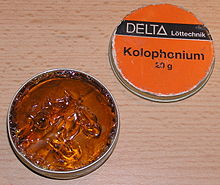
Back صهارة (علم الفلزات) Arabic Флюс Bulgarian Fundent Catalan Tavidlo Czech Flux (lodning) Danish Flussmittel (Löten) German Συλλίπασμα Greek Fundente Spanish فلاکس Persian Juoksute (tekniikka) Finnish
This article includes a list of general references, but it lacks sufficient corresponding inline citations. (February 2019) |




In metallurgy, a flux (from Latin fluxus 'flow') is a chemical cleaning agent, flowing agent, or purifying agent. Fluxes may have more than one function at a time. They are used in both extractive metallurgy and metal joining.
Some of the earliest known fluxes were sodium carbonate, potash, charcoal, coke, borax,[1] lime,[2] lead sulfide[3] and certain minerals containing phosphorus. Iron ore was also used as a flux in the smelting of copper. These agents served various functions, the simplest being a reducing agent, which prevented oxides from forming on the surface of the molten metal, while others absorbed impurities into slag, which could be scraped off molten metal.[4]
Fluxes are also used in foundries for removing impurities from molten nonferrous metals such as aluminium, or for adding desirable trace elements such as titanium.
As cleaning agents, fluxes facilitate soldering, brazing, and welding by removing oxidation from the metals to be joined. In some applications molten flux also serves as a heat-transfer medium, facilitating heating of the joint by the soldering tool or molten solder.
- ^ "The use of ... borax ... traced back to the ancient Egyptians, who used it as a metallurgical flux". Britannica.com. Archived from the original on 2012-01-14. Retrieved 2011-08-19.
- ^ Bhardwaj, Hari C. (1979). Aspects of Ancient Indian Technology (use of lime as a flux). Motilal Banarsidass. ISBN 81-208-3040-7. Archived from the original on 2017-11-03. Retrieved 2011-08-19.
- ^ "Metallurgy in southern South America, Smelting, p. 1659-60" (PDF). Archived from the original (PDF) on October 10, 2010. Retrieved 2011-08-19.
- ^ "What Is Solder Flux And How Do You Use It?". www.pcbgogo.com. Retrieved 2021-07-09.
© MMXXIII Rich X Search. We shall prevail. All rights reserved. Rich X Search